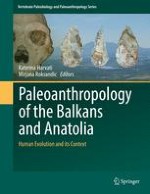
2016 | OriginalPaper | Chapter
1. Paleoanthropology in Greece: Recent Findings and Interpretations
Author : Katerina Harvati
Published in: Paleoanthropology of the Balkans and Anatolia
Publisher: Springer Netherlands
Activate our intelligent search to find suitable subject content or patents.
Select sections of text to find matching patents with Artificial Intelligence. powered by
Select sections of text to find additional relevant content using AI-assisted search. powered by